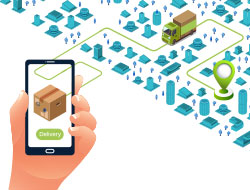07.31.18 By Bridgenext Think Tank

 Fleet Management, a manpower-oriented industry, can gain tremendous benefits from the integration of mobile app development into their logistics processes. These apps are so popular due to the significant reduction of time-consuming procedures as well as real-time tracking capabilities for vehicles and drivers for pickup management, on way transfer, delivery through calls and more. This real-time visibility helps logistics organizations meet and improve their key performance metrics for efficiency, safety and customer satisfaction.
Fleet Management, a manpower-oriented industry, can gain tremendous benefits from the integration of mobile app development into their logistics processes. These apps are so popular due to the significant reduction of time-consuming procedures as well as real-time tracking capabilities for vehicles and drivers for pickup management, on way transfer, delivery through calls and more. This real-time visibility helps logistics organizations meet and improve their key performance metrics for efficiency, safety and customer satisfaction.
To help logistics or transportation based organizations that are considering a location-based app, our mobility experts have compiled a few of the common questions received from clients during the planning and development of fleet management mobile applications.
Q1: What are the key considerations for remote vehicle monitoring through a mobile app?
Answer: Part of a Fleet management admins job is to ensure that deliveries are moving on schedule. Without automated means, the primary communication is a phone call to the driver at numerous times throughout the day for status updates. This manual “check-in” is frustrating for both the admin and the driver, taking time and focus away from other more important activities. With live vehicle and driver tracking provided through a mobile app, the entire process is automated- eliminating one less item to worry about!
With the costs of smartphones continually dropping, these devices can be provided to each driver with a mobile app that allows continuous monitoring and tracking via GPS and cameras. With the core feature of GPS, the real-time location of the driver can be traced. The phone’s front and rear cameras are also used for monitoring both driver activities and the road respectively. A live preview of the driver and truck can also be done easily with the help of live streaming software such as WOWZA, Kurento, Red5, etc.
As these apps use both cameras at the same time, battery consumption becomes a major concern, which must be considered and addressed. Based on tracking and monitoring requirements, the battery mode can be adjusted to prevent battery drain. For example, a high-performance battery mode can be selected in cases of heavy utilization and power saving mode for periodic updates.
Some helpful tips for organizations and their mobile app development teams are:
Q2: How can the mobile app help prevent unsafe driving?
Answer: If you are a fleet management company, this should be a top concern, keeping drivers as well as the public safe and sound. With Advanced Driver Assistance Systems Technology (ADAS) technology, the safety of drivers can be ensured. Today, it’s a highly cost-effective solution and operates well in carrying out image processing, utilizing mobile device cameras and in-vehicle networking. This high-level technology tracks and senses all kinds of events like sudden braking, G-shock, and sudden movements such as lane departure, over-speeding by the posted road sign, and more. Through a Google database or GPS, the speed limit can be located which helps an admin to decide the speed limit threshold. Real-time voice and visual warnings are sent in such scenarios to prevent the driver from any mishap or accident.
Q3: Is a driver’s log an integral part of the app?
Answer: Yes, it has to be. It is like an organization’s CCTV but it provides virtual tracking of a driver’s different activities. It provides key reporting including:
These details can help analyze driver utilization and efficiency in order to improve overall operations and return on investment.
Q4: Should the application support offline data capture?
Answer: This is a key functionality that should be included in an application of this nature. The apps used in logistics/transportation business should be able to operate in cases of complete absence of internet connectivity. No matter what the mobile companies tell you, the world is not 100% connected. Often, logistics activities take place on roads or in locations of intermittent or no connectivity. Data updates should still be captured by the app and sent back once the app gains connectivity to the network to guarantee comprehensive updates. Without this, the management of the entire supply chain will be affected.
Q5: How can the mobile app development help in minimizing legal risks?
Answer: Unwarranted Claims, legal disputes, and escalations are factors that all fleet companies strive to minimize as much as possible. Some events cannot be avoided completely but conditions that lead to them can be addressed to reduce or prevent their chances of occurring. A mobile app can provide a “safety net” through functionality including:
It is through intelligent video analysis, that administration is alerted and prompt actions are taken to prevent or resolve a mishap whether it is an accident, asset damage or other misfortune. In cases where there are unwarranted claims, recorded videos empower the organization to prevent litigation and fines.
Q6. Can we provide multilingual support for driver side of the mobile application?
Answer: Yes, absolutely. The application can be developed or customized for drivers from different backgrounds. Multilingual support enables the driver to choose their own language for a higher comfort-level while operating the app. This makes communication frictionless between the driver and administration team.
Q7: How can the app ensure that driver distractions are prevented?
Answer: There are technologies including SOTI, Jamf Pro, AirWatch, Hexnode MDM, Mobile Iron, etc. which can serve to safeguard driver safety by preventing driver distraction. Some of these solutions have built-in, anti-driver distraction policies that help ensure safe driving. It locks down devices or app based on the vehicle speed and limits mobile functionality by enabling a complete lockdown mode. This safeguards drivers and in turn their organizations, by preventing distractions that can lead to accidents.
Conclusion
Mobile applications for logistics can provide both driver assistance and better fleet reporting. The application’s ability to provide real-time information on the vehicle’s status, updates on driving scenarios, changes in situations and condition of assets helps vastly improve supply chain efficiency. We hope the above questions help you in understanding the functionality that these types of apps can provide.
If you are looking for a partner to help guide you in the development of a mobile application for your team, Contact us for a complimentary consultation. We offer a full range of enterprise mobility services that help our clients achieve their operational goals.